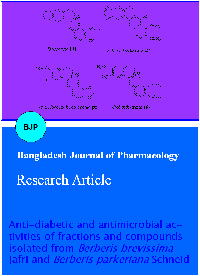Antidiabetic and antimicrobial activities of fractions and compounds isolated from Berberis brevissima Jafri and Berberis parkeriana Schneid
DOI:
https://doi.org/10.3329/bjp.v8i3.13888Keywords:
Antidiabetic, antimicrobial, Berberis brevissima, Berberis parkeriana, isoquinoline alkaloidsAbstract
Methanol extracts of the roots of B. brevissima and B. parkeriana were examined for antidiabetic and antimicrobial activities. Six compounds i.e berberine, 8-oxo-berberine, dehydrocheilanthifoline, columbamine, jatrorrhizine and gluta-mic acid were isolated from the active fractions of these species for the first time. The antidiabetic activity was determined against Protein Tyrosine Phosphatase 1B (PTP 1B), a negative insulin regulator while the antimicrobial activity was performed against four bacterial strains: Mycobacterium marinum ATCC BAA535, sporadic Methicillin Resistant Staphylococcus aureus (SMRSA), endemic Methicillin Resistant Staphylococcus aureus (EMRSA) and Escherichia coli ATCC.8739 at different concentrations. Amongst the isolated compounds 8-oxo-berberine was found to be the most active antidiabetic (29 % of the positive control) while jatrorrhizine was the most active and selective antimicrobial against SMRSA and EMRSA (-1.2% of the DMSO (D) control).
Downloads
794
552 Read
19
References
Aydemir N, Bilaloglu R. Genotoxicity of two anticancer drugs, gemcitabine and topotican, in mouse bone marrow in vivo. Mutat Res. 2003; 537: 43-51.
British Pharmacopoeia. Appendix 1A, A30, The Stationary Office, London, 2011, p 5.
Brag LC, Leite AA, Xavier KG, Takahashi JA, Bemquerer MP, Chartone-Souza E, Nascimento AM. Synergic interaction between pomegranate extract and antibiotics against Staphylococcus aureus. Can J Microbiol. 2005; 51: 541-47.
Choi JS, Yokozawa T, Oura H. Improvements of hyperglycaemia and hyperlipemia in streptozotocin diabetic rats by methanolic extract of Prunus dagidana stems and its main components pruning. Planta Med. 1991; 57: 208-11.
Cooper SF, Mockle JA, Santavy F. Revision of the structures of the alkaloids A and B isolated from Coptis groenlandica. Planta Med. 1972; 11: 313-21.
Dutta NK, Panse MV. Usefulness of berberine (an alkaloid from Berberis aristata) in the treatment of cholera. Indian J Med Res. 1962; 50: 732-35.
Eddouks M, Maghrani M, Michel JB, Hypoglycemic effect of Triticum ripens P. Beauv in normal and diabetic rat. J Ethanopharmacol. 2005; 102: 228-32.
Fajardo V, Elango V, Cassels BK, Shamma M. Chilenine: An Isoindolobenzazepine Alkaloid. Tetrahedron Lett.1982; 23: 39-42.
Freile ML, Giannini F, Pucci G, Sturniolo A, Rodero L, Pucci O, Balzareti V, Enriz RD. Antimicrobial activity of aqueous extracts and of berberine isolated from Berberis heterophylla. Fitoterapia 2003; 74: 702-05.
Gulfraz M, Mehmood S, Ahmad A, Fatima N, Praveen Z, Williamson EM. Comparison of the antidiabetic activity of Berberis lyceum root extract and berberine in alloxan induced diabetic rats. Phytother Res. 2008; 22: 1208-12.
Hsieh TJ, Chia YC, Wu YC, Chen CY, Chemical constituents from the stems of Mahonia japonica. J Chin Chem Soc. 2004; 51: 443-46.
IDF Diabetes Atlas. 5th ed. 166 Chaussee da la Hulpe B-1170 Brussels, Belgium (Accessed May 5, 2013, at www.idf.org/diabetesatlas/5e/the-global-burden).
Kumar S, Kumar V, Prakash OM, Antidiabetic and Antilipemic effects of Cassia siamea leaves extract in streptozotocin induced diabetic rats. Asian Pac J Trop Med. 2010; 3: 871-73.
Maqsood A, Alamgeer, Tanveer S. A potential adjunct to insulin: Berberis lycium Royle. Diabetologia Croatica 2009; 38: 13-18.
Meliani N, Amine ME, Dib, Allali H, Tabti B. Hypoglycaemic effect of Berberis vulgaris L. in normal amd streptozocin induced diabetic rats. Assian Pac J Trop Biomed. 2011; 1: 468-71.
Nicasio P., Santamaria AL, Aranda E, Ortiz S, Gonzalez M. Cytotoxic isoflavones from Erythrina indica. Phytochemistry 2011; 58: 1113-20.
Schito GC. The importance of the development of antibiotic resistance in Staphylococcus aureus. Clin Microbiol Infect. 2006; 12: 3-8.
Shahid M, Rahim T, Shahzad A, Tajuddin, Latif A, Fatma T, Rashid M, Raza A, Mustafa S. Ethnobotanical studies on Berberis aristata DC. root extracts. Afr J Biotechnol. 2009; 8: 556-63.
Singh M, Srivastava S, Rawat AKS. Antimicrobial activities of Indian Berberis species. Fitoterapia 2007; 78: 574-76.
Suau R, Rico R, Romero JML, Najera F, Cuevas A. Isoquinoline alkaloids from Berberis vulgaris Subsp. australis. Phytochemistry 1998; 49: 2545-49.
Tanaka R. New polar constituents of the pupae of the silkworm Bombyx mori L. Isolation and identification of Methionine Sulfoxide, Methionine Sulfone and ?-cyclic di-L-Glutamate. Biosci Biotechnol Biochem. 2007; 71; 3055-62.
Uniyal MR, Tewari LC. Anticancer drugs from U. P. Himalaya. Anc Sci Life 1991; 11: 50-55.
Upwar N, Patel R, Waseem N, Mahobia NK. Hypoglycemic effect of methanolic extract of Berberis aristata DC stem on normal and streptozotocin induced diabetic rats. Int J Pharm Pharmaceuti Sci. 2011; 3: 222-24.
Wagh S, Vidhale NN. Antimicrobial activity of Berberis aristata against some human pathogenic bacteria and fungi. Biosci Biotechnol Res Comm. 2010; 3: 38-42.
World Health Organization (WHO), 2009. Prevalence data of diabetes worldwide http://www.who.int/mediacentre/factssheets/fs312/en/index.html.
Xu SZ, Zhang Y, Ren JY. Effects of berberine of L- and T-type calcium channels in guinea pig ventricular myocytes. Zhongguo Yao Li Xue Bao 1997; 18: 515-18.
Zhang W, Hu JF, Lv WW, Zhao QC, Shi GB. Antibacterial, antifungal and cytotoxic isoquinoline alkaloids from Litsea cubeba. Molecules 2012; 17: 12950-60.

Published
How to Cite
Issue
Section
License
Authors who publish with this journal agree to the following terms:
- Authors retain copyright and grant the journal right of first publication with the work simultaneously licensed under a Creative Commons Attribution License that allows others to share the work with an acknowledgement of the work's authorship and initial publication in this journal.
- Authors are able to enter into separate, additional contractual arrangements for the non-exclusive distribution of the journal's published version of the work (e.g., post it to an institutional repository or publish it in a book), with an acknowledgement of its initial publication in this journal.
- Authors are permitted and encouraged to post their work online (e.g., in institutional repositories or on their website) prior to and during the submission process, as it can lead to productive exchanges, as well as earlier and greater citation of published work (See The Effect of Open Access).
